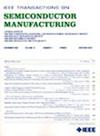Effects of the Applied Power of Remote Plasma System With Green Alternative Chamber Cleaning Gas of Carbonyl Fluoride
IF 2.3
3区 工程技术
Q2 ENGINEERING, ELECTRICAL & ELECTRONIC
引用次数: 0
Abstract
An effort to find an alternative dry-cleaning process gas with low global warming potential (GWP) has been conducted to decrease greenhouse gas emissions. Carbonyl fluoride (COF2) is one of the candidates as an alternative gas for plasma-enhanced chemical vapor deposition (PECVD) chamber cleaning because of its lower GWP compared to the currently employed氟羰基清洁气对远程等离子体系统应用功率的影响
为了减少温室气体的排放,人们正在努力寻找一种具有低全球变暖潜能值(GWP)的替代干洗过程气体。羰基氟化物(COF2)是等离子体增强化学气相沉积(PECVD)室清洗的备选气体之一,因为与目前使用的$\ mathm {NF}_{\ mathm{3}}$气体相比,它的GWP更低。含有等离子体源功率的干洗工艺条件与清洗气体的解离速率和干洗性能有关。本文研究了远端等离子体功率对COF2净化速率的影响,以及在稀释气体$\ mathm {O}_{\ mathm{2}}$和Ar中对COF2净化速率的影响。通过数值分析和实验对比,我们发现功率的变化会引起混合气体中不同物质的产生速率。在$\ mathm {O}_{\ mathm{2}}$稀释的情况下,氧自由基在等离子体中占优势,并与氧自由基反应产生稳定的副产物$\ mathm {CO}_{\ mathm{2}}$,生成更多的氟原子和自由基。我们得出结论,氧自由基在COF2的解离,氟自由基的产生中起重要作用,并有助于减少清洁抑制剂(如C-C和C-F化合物)的数量。用于清洁气体的额外稀释气体影响物种的产生机制和速率。
本文章由计算机程序翻译,如有差异,请以英文原文为准。
求助全文
约1分钟内获得全文
求助全文
来源期刊

IEEE Transactions on Semiconductor Manufacturing
工程技术-工程:电子与电气
CiteScore
5.20
自引率
11.10%
发文量
101
审稿时长
3.3 months
期刊介绍:
The IEEE Transactions on Semiconductor Manufacturing addresses the challenging problems of manufacturing complex microelectronic components, especially very large scale integrated circuits (VLSI). Manufacturing these products requires precision micropatterning, precise control of materials properties, ultraclean work environments, and complex interactions of chemical, physical, electrical and mechanical processes.
 求助内容:
求助内容: 应助结果提醒方式:
应助结果提醒方式:


